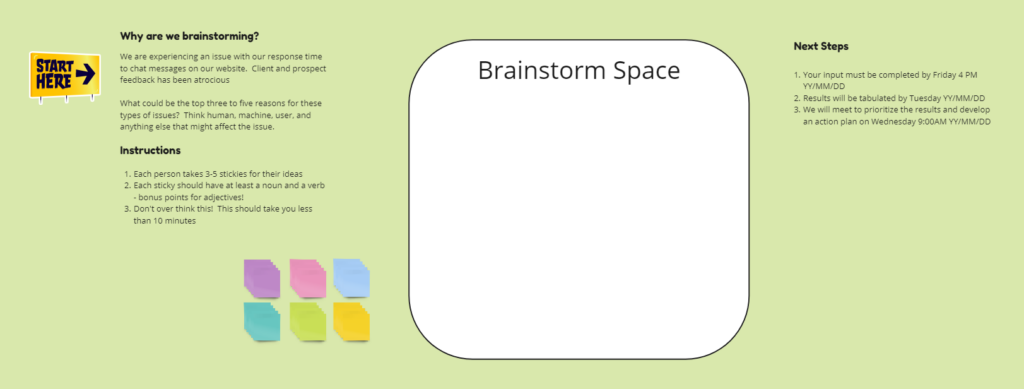According to Computerworld Magazine, surveys show that about 75% of people consider themselves extroverts, but anecdotal evidence indicates that the majority of IT folks are introverts.
While a broad generalization, suffice it to say that digital project managers will interact with multiple personalities and preferences. There will always be those introverted folks that you want to make sure to engage in your projects so they can supply their expertise.
This might require you to employ a technique such as silent brainstorming to make sure they get heard and not drummed out by the extroverts in the room. Silent brainstorming is a great addition to your toolkit of brainstorming techniques.
I’m Annie MacLeod, a passionate and seasoned project manager and coach who thrives on building collaboration experiences for remote teams and their projects. I’m also a devout introvert!
Over the years, as I’ve better understood what that means, I’ve been able to build collaboration practices that harness the knowledge of introverts and get them more engaged in my projects.
If you’re interested in learning more about introverts, I highly recommend the book Quiet, The Power of Introverts In a World That Can’t Stop Talking by Susan Cain. It provides great insights into what it means to be an introvert, as well as techniques to manage situations that can be overwhelming.
What Is Silent Brainstorming?
Brainstorming sessions are a key collaborative technique that is used in business today, particularly for projects. For digital project managers, there are lots of ways that group brainstorming helps solve problems, ideate solutions, develop content, plan, and do retrospectives.
Silent brainstorming sessions just take the ‘storming’ part and quiet it down so that it's not about the loudest voice in the room, which allows for more thoughtful input to the brainstorming process.
The added benefit of silent brainstorming is that it can be done asynchronously, so people can provide input regardless of the time zone they are in and you can save precious meeting time for digging deep on the brainstorming inputs, especially when you’re on a time limit.
Why Do It: How Silent Brainstorming Engages Introverts
I love this quote from the folks at mindmanager.com:
Brainstorming allows people to think more freely, without fear of judgment. Brainstorming encourages open and ongoing collaboration to solve problems and generate innovative ideas. Brainstorming helps teams generate a large number of ideas quickly, which can be refined and merged to create the ideal solution
This highlights what we are trying to achieve in our brainstorming: lots of rapid ideas while avoiding groupthink.
| Brainstorming | Happy Introverts | Silent Brainstorming Techniques |
|---|---|---|
| Think freely | Respect their space | Digital whiteboard space to provide input |
| No judgment | Give them time to recharge | Asynchronous time to provide input |
| Collaboration | Engage them in deep conversations | Anonymous input |
| Large number of ideas | Slow down & let them talk | More text, less talk |
How To Do Silent Brainstorming
There are some basic best practices when doing brainstorming, and the best place to start is framing the session (ie. what are we here to brainstorm about?) and providing context for the brainstorming. This context is all about the why—the reasons for doing this exercise.
For example:
| Type | How to Frame |
|---|---|
| Ideation | Example: “We are building a website that will need to sell x product to y audiences.” Provide any other information from the client about what would make this site successful. An example question to frame the brainstorming might be: “What would be your top three to five must haves for this type of website?” |
| Problem Solving | Example: “We are experiencing an issue with our response time to chat messages on our website. Client and prospect feedback has been atrocious.” An example problem statement to frame the brainstorming might be: “What could be the top three to five reasons for these types of issues? Think human, machine, user, or anything else that might affect the issue.” |
| Retrospective | Example: “We had a great sprint—the team work was amazing” An example question to frame the brainstorming might be: “What were the top three to five things that would make for a great team that works well together?” |
The next step is to provide space for the team to contribute their ideas. This could be in a Google Sheet, whiteboard, or Google Doc. You want to have a space that is readily accessible, shareable with the members of the group, and that allows you to collate the results easily.
In Miro I would set-up a space that looks like:

As you can see, I started with a clear framing statement and visually showed where to start. Next, I provided clear instructions on how to complete the brainstorming session. This would apply whether you were doing this in a live meeting or asynchronously.
It's important to have instructions written down and visible to folks to reiterate what they are to do. Countless times I find people go back to these when they forget what they were there to do along the way!
Lastly we clearly let them know what the next steps are—this is really important so that people understand the value they are providing and what will be expected of them in relation to the inputs.
Silent Brainstorming In Action
Let's explore when and where you might utilize these techniques in your digital project:
- Retrospectives: This is probably the number one use case—if you truly want to get frank, constructive feedback and minimize finger pointing, silent brainstorming should be the go to method for your next retrospective.
- Problem Solving: When a problem is initially discovered and it's unclear whether it's a bug, a change, or a training issue and you’re trying to get everyone’s input on the cause, it can be effective to gather input from everyone who’s observed the problem. When there’s multiple aspects to a problem and you’re developing potential solutions, brainstorming can help gather all the technical expertise required to develop the scope of the solution.
- Developing team norms: Silent brainstorming is a great exercise to tap into the diversity of your team and to generate ideas on how to communicate, the culture you aspire to, how you might facilitate team building, and how to collaborate.
So if we take the board above as an example, let's break it down into the steps you would do:
- Set-up space for your brainstorming session. Be sure to include the key elements of:
- Framing the brainstorm: Why are we doing this brainstorming? For our team norms example you’d say something like: “Give us all the best practices you’ve worked with as a project team member and put them in the brainstorm space.”
- Add an instruction section: I tell folks to be sure they take x number of stickies, and to have a noun and a verb on each thought (with bonus points for adjectives).
- Provide them with sticky note stacks so they can focus on the content instead of copying and pasting new sticky notes.
- Next steps: Outline what comes next as a result of the brainstorming. This would include when their input is due and when the group will convene to group the results and develop actions.
- Invite the team that will participate in the brainstorming session, and have clear instructions of what is expected of them during the session and the link to the board. Also, don’t forget to potentially include some links to tutorials or instructions to new team members not familiar with your technology!
- Follow-up to let people know that you appreciate their input and confirm the next meeting. Otherwise folks won’t bother next time you send a request out!
Key Takeaways
So why does this work so well for introverts? Here’s the key points:
- Digital whiteboards give us the freedom to participate and collaborate at our own pace. By doing the exercise asynchronously you allow folks to take the time to gather their thoughts and express them thoughtfully without glaring eyes observing how many they have or what they wrote. The added bonus is that these tools have spell check and you don’t have to scribe all the notes—an added bonus for us introverted facilitators!
- Doing the brainstorming session digitally allows the team to gather their thoughts and clearly articulate them in text instead of having to vocally articulate them.
- The technique saves meeting time for the deeper conversations about grouping and developing actions from the brainstorming, because people can see the input of the entire group prior to the meeting. That also helps them recharge before this next activity as well as prepare for the next one.
- Because the input is anonymous, it avoids the situation where whoever has the loudest voice or the biggest title has more weight put on their input. This so often happens in environments where the extroverts can monopolize the conversation!
You can find more collaboration best practices here, and if you want some more ideas on how to get started brainstorming in your next project check out:
- Check out the other resources you have access to as a DPM member—articles, podcasts, and tool recommendations.
- Try out my template in the Miroverse for scoping projects and relating success criteria to deliverables.
Lastly if you subscribe to The Digital Project Manager newsletter, you’ll keep up to date on all the DPM expert input.


